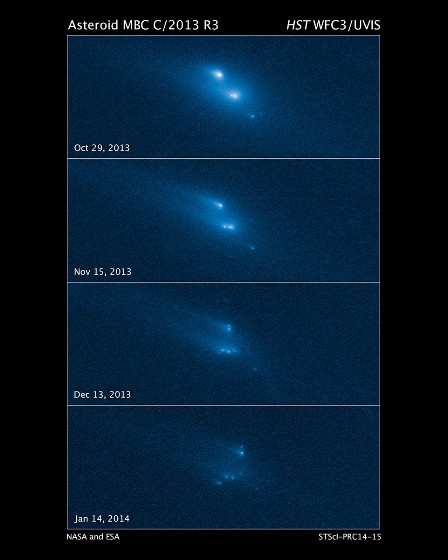Mysterious Disintegration of Asteroid P/2013 R3 Captured on Film

The mysterious disintegration of an asteroid has been captured on film for the first time, showing it crumbling into around 10 smaller pieces.
Using Nasa's Hubble Space Telescope, astronomers at University of California, Los Angeles (UCLA) photographed asteroid P/2013 R3 breaking up into small pieces.
Over four months, from October last year, astronomers watched the fragile comet nuclei falling apart – the first time this type of breakup has been recorded in the asteroid belt.
P/2013 R3 was first spotted in September last year. Further observations from the WM Keck telescope on Hawaii's Mauna Kea showed three bodies inside a dusty envelope about the diameter of Earth.
David Jewitt, lead investigator, said: "Seeing this rock fall apart before our eyes is pretty amazing. The Keck telescope showed us that this asteroid was worth looking at with Hubble."
Published in the Astrophysical Journal Letters, Hubble showed there were 10 objects each with a comet-like dust tail. The four largest fragments measured around 200 yards in radius – about the length of two football fields. In total, its debris weights around 200,000 tonnes.
Astronomers saw the fragments were moving away from one another, at a rate of about a mile per year.
The researchers said the asteroid is not disintegrating because of a collision with another space object, or that it is falling apart because of pressure on the interior ices warming and vaporising.
Jewitt said the only remaining scenario is that the asteroid is disintegrating because of the effect sunlight has on its rotation. He compared the effect to that of a bunch of grapes, where the fruit eventually falls from the stem because of movements.
This force is known as Yorp torque. While it has been identified by scientists, it has only now been observed.
The astronomers say P/2013 R3 must have a weak and fractured interior, adding it is probably the product of a collision of a much larger asteroid at some point in the last billion years.
Jewitt said that the asteroid will eventually provide a rich source of meteorites, with some expected to fly past Earth. Most will end in a fiery death after being dragged into the Sun.
© Copyright IBTimes 2025. All rights reserved.






















